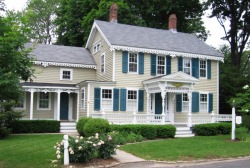Residential real estate

The legal arrangement for the right to occupy a dwelling is known as the housing tenure. Types of housing tenure include owner occupancy, Tenancy, housing cooperative, condominiums (individually parceled properties in a single building), public housing, squatting, and cohousing.
When one or more tenants live together, they may choose to split the cost of residency through a net lease. To save money having a residence, tenants may have the option to have a net lease. The only cost of this would be having to share the residence with another tenant. Net leases come in many different forms including: single, double, and triple net leases; depending on how many tenants are sharing the net lease.[6]
Residences can be classified by, if, and how they are connected to neighboring residences and land. Different types of housing tenure can be used for the same physical type. For example, connected residents might be owned by a single entity and leased out, or owned separately with an agreement covering the relationship between units and common areas and concerns.
It can be described more roughly by the number of rooms. A studio apartment has a single bedroom with no living room (possibly a separate kitchen). A one-bedroom apartment has a living or dining room separate from the bedroom. Two bedroom, three bedroom, and larger units are common. (A bedroom is defined as a room with a closet for clothes storage.)
See List of house types for a complete listing of housing types and layouts, real estate trends for shifts in the market and house or home for more general information.
When one or more tenants live together, they may choose to split the cost of residency through a net lease. To save money having a residence, tenants may have the option to have a net lease. The only cost of this would be having to share the residence with another tenant. Net leases come in many different forms including: single, double, and triple net leases; depending on how many tenants are sharing the net lease.[6]
Residences can be classified by, if, and how they are connected to neighboring residences and land. Different types of housing tenure can be used for the same physical type. For example, connected residents might be owned by a single entity and leased out, or owned separately with an agreement covering the relationship between units and common areas and concerns.
- Attached / multi-unit dwellings
- Apartment - An individual unit in a multi-unit building. The boundaries of the apartment are generally defined by a perimeter of locked or lockable doors. Often seen in multi-story apartment buildings.
- Multi-family house - Often seen in multi-story detached buildings, where each floor is a separate apartment or unit.
- Terraced house (a.k.a. townhouse or rowhouse) - A number of single or multi-unit buildings in a continuous row with shared walls and no intervening space.
- Condominium - Building or complex, similar to apartments, owned by individuals. Common grounds are owned and shared jointly. There are townhouse or rowhouse style condominiums as well.
- Semi-detached dwellings
- Duplex - Two units with one shared wall.
- Single-family detached home
- Portable dwellings
- Mobile homes - Potentially a full-time residence which can be (might not in practice be) movable on wheels.
- Houseboats - A floating home
- Tents - Usually very temporary, with roof and walls consisting only of fabric-like material.
It can be described more roughly by the number of rooms. A studio apartment has a single bedroom with no living room (possibly a separate kitchen). A one-bedroom apartment has a living or dining room separate from the bedroom. Two bedroom, three bedroom, and larger units are common. (A bedroom is defined as a room with a closet for clothes storage.)
See List of house types for a complete listing of housing types and layouts, real estate trends for shifts in the market and house or home for more general information.
